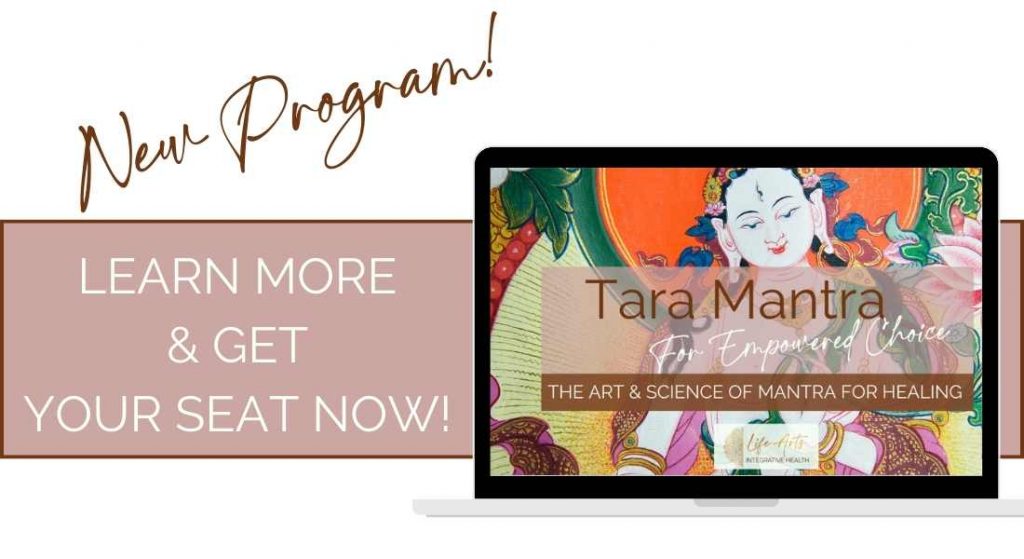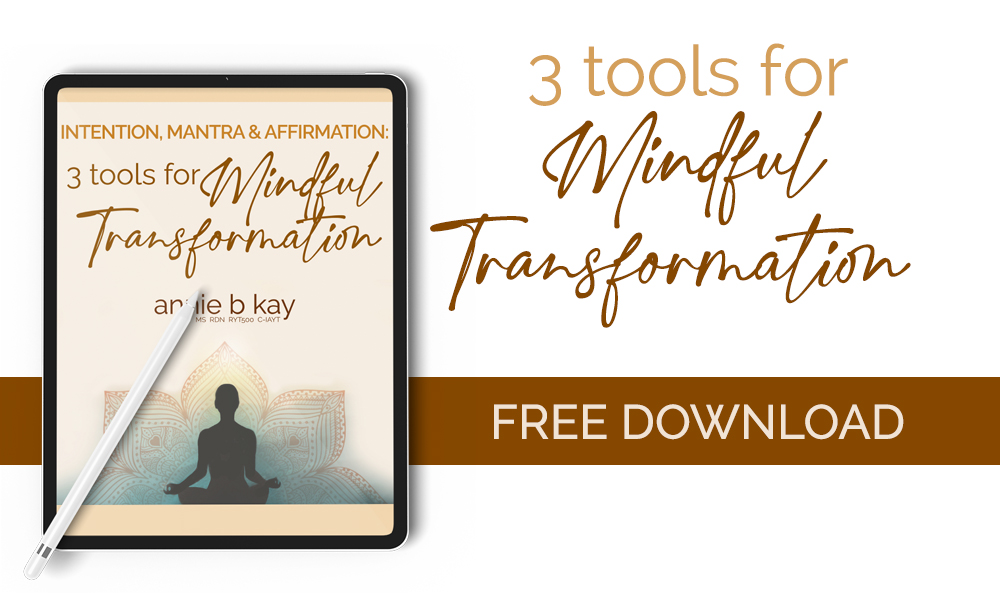Om gum
Ganapatayei
Namaha
Teaching recently on using intention, mantra and affirmation for lifestyle change, I was reminded why I love this delicious vibrational medicine. The room was filled with seekers, some of whom had chanted before, others who’d practiced reminiscent rituals like praying the rosary.
As we honored Ganesh (the beloved elephant-headed, mama-loving archetype of the tantric pantheon) through mantra, I could feel their voices as vibration in my center, deep in my bones. Sound emanated from within each being, voices distinct yet interwoven, forming a collective fabric tenting us in sound-song. It was a pulsing prayer to Ganesh, the remover of obstacles. Eyes closed, bodies swayed in open-hearted rhythm. The capillary-like channels (nadis, in the ancient language of Sanskrit) of our energy bodies plucked like strings, vibrating in mantra meditation.
This article is a brief introduction to the rich energy medicine of mantra meditation. Please know that we just scratch the surface of this profound tool for healing in this article. Stay close to me, friends, to dive deeper!
- Annie
What is Mantra Meditation?
Mantra is a Sanskrit word that roughly translates as: Mind (Man) Free (tra).
Vibrational in action, mantra is chanted repetition of a sacred sound, or an affirmation with the aim of calming and focusing your mind. Doing that helps you shift to a more meditative state of consciousness. It often draws from words in the ancient languages of Sanskrit, Pali, or Latin, and is often a prayer, an honoring or request of a saint or an advanced soul.
Mantra is a form of meditation. Meditation is a practice wherein you change your consciousness in order to achieve something. Meditative consciousness tends include a soft relaxed awareness, a focus (in mantra meditative the mind is focused on the sound or words of the mantra), a quiet yet attentive mind, and an attitude of kind compassion.
As a dietitian and yoga therapist (get to know me better here), I use mantra in my clinical practice to help you change your mindset, food choices and lifestyle choices such as moving more, managing stress mindfully and get enough constructive rest. Practicing these shifts can help you address looming medical issues or to enhance your energy. I often use mantra in combination with setting intention (getting clear on what you are seeking or why you want to change), and with creating affirmations (intentions in present action). These add-ons help focus and charge your mantra meditation, and boost your likelihood of getting the results you seek.
Chanting meditation is well suited to people who struggle with the discipline of quiet stillness. If you have an ‘active mind’ that has trouble settling down, mantra can provide your mind a strong focus. One of my teachers calls it giving the mind a bone. That sounds right! Your busy mind has something to do. Certainly if you love to sing, mantra meditation may feel joyful and natural for you. Now let's talk about the words that make up mantras.
Each mantra is a poem or prayer. It has a focus. In the case of the Ganesh mantra, we honor the remover of obstacles and ask him to help us clear out the mental, physical and unknown cobwebs that prevent us from being in loving service to all beings everywhere. Ganesh helps us to let go. When we are able to let go, it's easier to embrace and reinforce the new, the wisdom-informed.
Western Science, Mantra & Meditation
Science supports the use of mantra and more generally, meditation, for a number of health conditions. Here is a brief round-up of the science:
A 2022 meta-analysis of mantra meditation for mental health suggested benefit anxiety, depression and stress. Effects tended to be small to moderate. Reviewers noted that Western science on this topic is new, and many studies are underway to explore the answers to the many remaining questions of just how contemplative practice does what it does, and interfaces with your brain and your life.
The National Center for Complementary & Integrative Health (NCCIH) has reported that meditation is generally safe, and there is quality research supporting the use of meditation to address high blood pressure, symptoms of irritable bowel syndrome, anxiety and depression, and insomnia. There is limited science suggesting benefits of using meditation for pain and smoking cessation.
There have also been some fascinating studies about how meditation impacts our brain. In one study researchers compared the brain images of 50 adults who meditate, with 50 who do not. Those who meditated for many years had more folds in the outer grey matter of the brain. Gyrification, the process of creating your brain's folds, may increase your ability to process information.
Meditation may slow, stall or even reverse changes that take place in the brain due to normal aging.
A JAMA meta-analysis suggested that meditation addresses stress and can reduce anxiety, depression and pain.
A 2014 Indian review of meditation from a decidedly yoga-supportive perspective suggests that different mantras can create different effects in the body and life of the practitioner. This is in agreement with longtime Master teachers of mantra.
The science of mantra and meditation is young - it's just getting started! Studies tend to be small and the research is outside of the usual research industrial complex. However, more bright young researchers are moving toward mindful neuropsychology now that Western science knows enough about the brain to move meditation out of the woo-woo shadows. That bodes well for yoga teachers, integrative health pros, and people like you were are interested in accessible solutions that work.
Neuropsychological mechanisms - how mantra works
If you think about a habit from a neuropsychological view, mantra makes sense as a change-helper. Habits are neural short-cuts. They are collections of neural pathways that fire together and remember.
Think about the habit of having a drink at 4p - the sacred hour of happy in my home growing up. Each day, my parents didn't need to check their notes on how to make a Manhattan or even to ask if the other wanted a drink. At 3:45 every single day, my Dad closed the door of his home-office, and the ritual began. It was automatic. The same co-firing happens when it's time to brush your teeth, or when you've had a stressful day and you remember that a glass of wine or piece of chocolate helped you feel better. The habit is formed, engrained.
Mindfulness meditation - paying attention to the habit in a moment by moment way - can help with the re-wiring. It has actually been shown to be quite effective. Mantra meditation is similar to mindfulness meditation in that it provides the brain the time and the cue to look at things differently. Mantra has a couple other interesting characteristics as well.
Mantra is movement - vibration. Yoga provides a number of intersting ways to think about your human body, and one way is organized around a vibrating crystal (your bones). Chanting vibrates your body - check it out! All communication comes down to light and sound - both of which have frequency - waves. Vibrating your body - through song or chant - tends to feel good and help us to shake it off. Whatever it may be. And, if certain frequencies carry certain messages - they imagine if you start vibrating to peace, love and abundance.
Get Started with Mantra Meditation
Begin your practice by setting an intention. Setting an intention helps you to focus your mantra and brings the mantra deeper into your personal circumstance. Please note that this is how I, as a teacher-healer, work with mantra.
Struggling to begin your intention setting? I can help. Scroll down to download my free workbook on this topic: 3 tools for Mindful Transformation. It’s seven pages that will take you step-by-step through setting intention, chanting a mantra, and then creating affirmations to help bring your intention to life.
Easy Effective Sanskrit Mantras
Here are a few popular classic mantras that can benefit nearly anyone. You might chant one repeatedly as you walk around the block, or find a string of mala beads and chant the mantra 108 times. Several numbers keep coming up in the yogic world, and 108 is one of them. It is thought that if you chant your mantra 108 times, you will have touched each of the delicate energy channels (nadis) of your body with the vibrational energy of the mantra. If you chant out loud you're directing your chant to your physical body, chanting silently directs the chant to your mental and subtle (unseen) bodies.
Popular Sanskrit Mantras:
Om (Aum, ohm)
Om is thought to be the source sound of creation and the universe. It is thought to be the source mantra from which all others arise.
Om Shanti
Shanti means peace, and this mantra is a prayer for peace on all levels for all beings everywhere.
Sat Nam
This mantra means I am the truth. Truth is my name.
Om Namah Shivaya
A bow to Shiva, the eternal observer, the meditative witness, the divine masculine, this mantra honors he who can help you to know your own divine nature.
Om Shri Danvantre Namaha
A bow to Danantre, the celestial healer, and a prayer of healing and to draw to you your healers
The classical mantra meditations I teach are in Sanskrit. That doesn’t mean, however, that you have to chant in Sanskrit to receive a benefit from mantra meditation. The medicine is in the repetition, held with intention and focusing your mind on the mantra.
English Language Mantras
If Sanskrit mantras just feel funny, you might use the following phrases in the same way:
I think I can
Every Day in Every Way, I’m getting Better & Better
May I be happy, healthy and free. May you be happy, healthy and free. May we be happy healthy and free.
You might think about a sweet childhood song you learned long ago, or a spiritual hymn that moves you. Inspiring words and phrases are everywhere - google it!
Going Deeper - a word on Gurus,
Anyone can benefit from chanting simple mantras with an open heart as a prayer. Traditionally, mantras were given to students by a guru. A guru is a spiritual teacher, who is hopefully an advanced soul. In the Western world of yoga, the guru-teacher model has suffered from a great number of scandals, usually related to a powerful person misusing their power and the responsibility that accompanies it.
Today, there are many master-teachers, some of whom are advanced souls, who acknowledge a need to "become our own guru". It's an empowered spiritual model of learning, and perhaps admiring a teacher while being aware of your own boundaries, and understanding that a relationship between a master (or the CEO of the yoga center), and their student or subordinate is inherently problematic ethically. There are widespread issues around this whenever power is at play - we humans seems to have a hard time with power.
Planets,
Rhythmic by nature, master-teachers often tie mantra into astrology, the cyclical movement of the planets. For more specific or personal mantra development, your personal astrology and planetary astrology comes into play. It gets complicated. Just know that as you learn and practice mantra, much like yoga it is a long term ever-deepening practice. Likewise, numbers come into play.
& Numbers
Certain numbers pop up over and over in the world of yoga, and in spiritual traditions. We mentioned chanting your mantra 108 times. The numbers 40 and 7 also pop up a lot. Why these numbers pop up is a lovely collection of stories and observations. Many of the spiritual traditions borrow these numbers from one another - there has been lots of sharing going on over the millenia! Suffice it to say, to do your practice daily for 40 days is a wonderfully powerful practice. As we think about mantra as a tool for healing, using the seven chakras, or the planets for various aims can make this practice powerful. Do you alwasy get what you want? Hell no! But as Mick Jagger says....
You get what you need.
So, What's Next?
Hot off the program press is a Mantra for Healing self-study blended (personal and group) online program.
Tara is the enlightened goddess of compassionate creativity. She can give you the energy, healing, abundance and empowered action to support your health and life.
Learn more! 
If you or someone you love is interested in working privately, check out Truly Nourished, a high-impact personal program that blends nutrition clinical science with the wisdom of yoga and meditation. Read more about my coaching practice.
Ready to chat with me about your situation? Reach out to my administrator Jamie to arrange a free discovery call.
Do you have a favorite mantra or song you sing to cheer yourself up, or keep yourself pressing on? Share it with us!
Have you struggled to stick with your mantra meditation practice? Or, have your overcome mantra inertia? Let's share our experiences with mantra in the comments.




